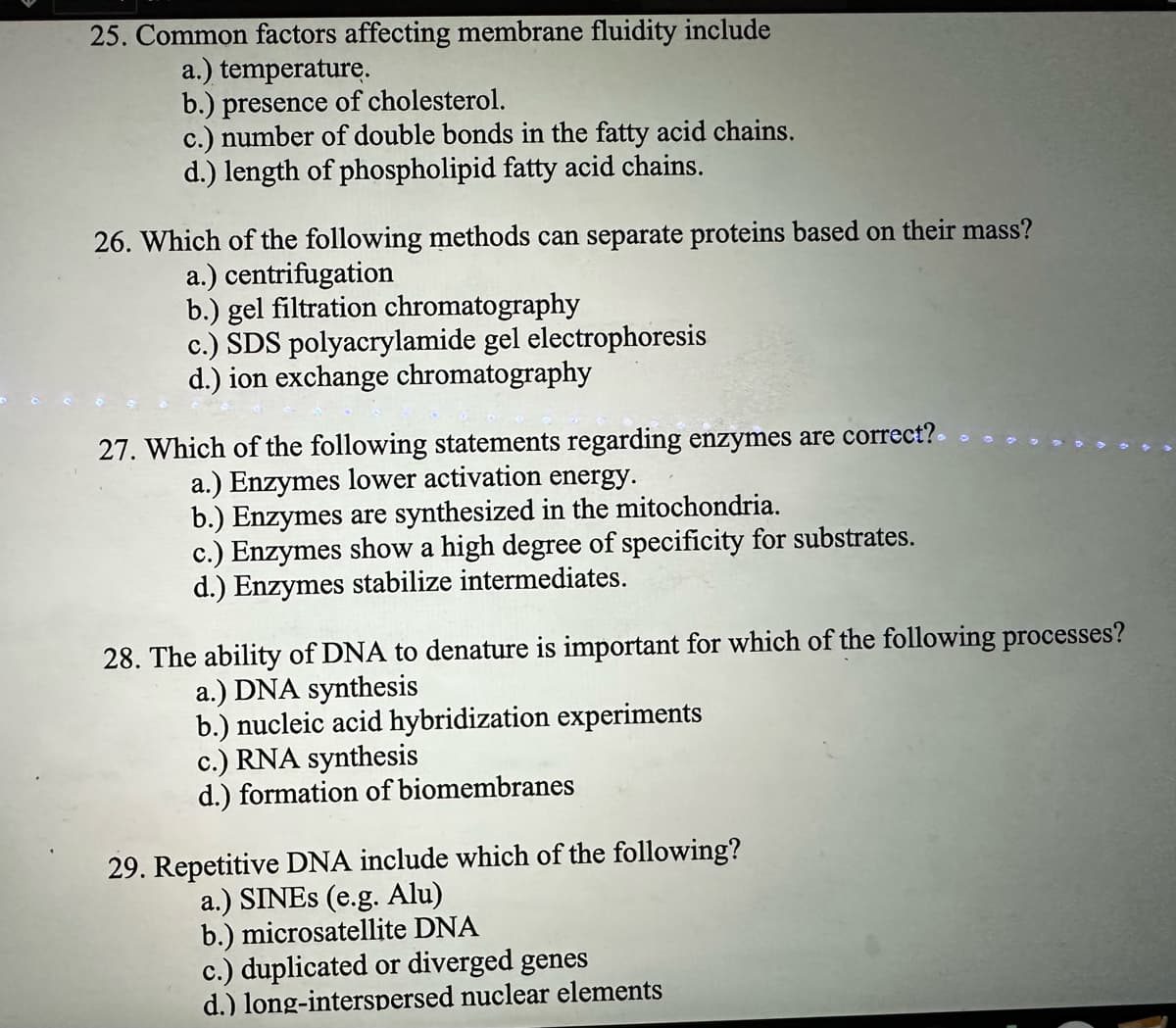25. Common factors affecting membrane fluidity include a.) temperature. b.) presence of cholesterol. c.) number of double bonds in the fatty acid chains. d.) length of phospholipid fatty acid chains. 26. Which of the following methods can separate proteins based on their mass? a.) centrifugation b.) gel filtration chromatography c.) SDS polyacrylamide gel electrophoresis d.) ion exchange chromatography 27. Which of the following statements regarding enzymes are correct? a.) Enzymes lower activation energy. b.) Enzymes are synthesized in the mitochondria. c.) Enzymes show a high degree of specificity for substrates. d.) Enzymes stabilize intermediates. 28. The ability of DNA to denature is important for which of the following processes? a.) DNA synthesis b.) nucleic acid hybridization experiments c.) RNA synthesis d.) formation of biomembranes 29. Repetitive DNA include which of the following? a.) SINES (e.g. Alu) b.) microsatellite DNA c.) duplicated or diverged genes d.) long-interspersed nuclear elements
25. Common factors affecting membrane fluidity include a.) temperature. b.) presence of cholesterol. c.) number of double bonds in the fatty acid chains. d.) length of phospholipid fatty acid chains. 26. Which of the following methods can separate proteins based on their mass? a.) centrifugation b.) gel filtration chromatography c.) SDS polyacrylamide gel electrophoresis d.) ion exchange chromatography 27. Which of the following statements regarding enzymes are correct? a.) Enzymes lower activation energy. b.) Enzymes are synthesized in the mitochondria. c.) Enzymes show a high degree of specificity for substrates. d.) Enzymes stabilize intermediates. 28. The ability of DNA to denature is important for which of the following processes? a.) DNA synthesis b.) nucleic acid hybridization experiments c.) RNA synthesis d.) formation of biomembranes 29. Repetitive DNA include which of the following? a.) SINES (e.g. Alu) b.) microsatellite DNA c.) duplicated or diverged genes d.) long-interspersed nuclear elements
Biology 2e
2nd Edition
ISBN:9781947172517
Author:Matthew Douglas, Jung Choi, Mary Ann Clark
Publisher:Matthew Douglas, Jung Choi, Mary Ann Clark
Chapter4: Cell Structure
Section: Chapter Questions
Problem 41CTQ: How does the structure of a plasmodesma differ from that of a gap junction?
Related questions
Question
100%
There may be multiple answers for each question.

Transcribed Image Text:25. Common factors affecting membrane fluidity include
a.) temperature.
b.) presence of cholesterol.
c.) number of double bonds in the fatty acid chains.
d.) length of phospholipid fatty acid chains.
26. Which of the following methods can separate proteins based on their mass?
a.) centrifugation
b.) gel filtration chromatography
c.) SDS polyacrylamide gel electrophoresis
d.) ion exchange chromatography
27. Which of the following statements regarding enzymes are correct?
a.) Enzymes lower activation energy.
b.) Enzymes are synthesized in the mitochondria.
c.) Enzymes show a high degree of specificity for substrates.
d.) Enzymes stabilize intermediates.
28. The ability of DNA to denature is important for which of the following processes?
a.) DNA synthesis
b.) nucleic acid hybridization experiments
c.) RNA synthesis
d.) formation of biomembranes
29. Repetitive DNA include which of the following?
a.) SINES (e.g. Alu)
b.) microsatellite DNA
c.) duplicated or diverged genes
d.) long-interspersed nuclear elements
Expert Solution
This question has been solved!
Explore an expertly crafted, step-by-step solution for a thorough understanding of key concepts.
Step by step
Solved in 4 steps

Knowledge Booster
Learn more about
Need a deep-dive on the concept behind this application? Look no further. Learn more about this topic, biology and related others by exploring similar questions and additional content below.Recommended textbooks for you

Biology 2e
Biology
ISBN:
9781947172517
Author:
Matthew Douglas, Jung Choi, Mary Ann Clark
Publisher:
OpenStax

Biology 2e
Biology
ISBN:
9781947172517
Author:
Matthew Douglas, Jung Choi, Mary Ann Clark
Publisher:
OpenStax